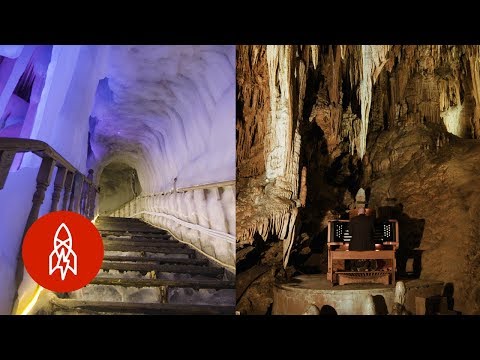
The allure of exploring caves is as old as humanity itself. Each cave around the world tells a different story, shaped by millennia of history, geology, and cultural significance. From subterranean ecosystems teeming with unique wildlife to ancient human artifacts preserved for thousands of years, caves are natural time capsules and wonders of the natural world. Join us on an exploratory journey through six of the most captivating caves across different continents, each offering a unique window into the planet’s past and present.
**1. Waitomo Glowworm Caves – New Zealand**
In the heartland of New Zealand’s North Island lies a cave system that offers a celestial experience unlike any other. The Waitomo Glowworm Caves are renowned for their populations of Arachnocampa luminosa, a species of glowworm indigenous to New Zealand. These tiny creatures emit a luminescent glow, illuminating the cave ceilings in a starry display reminiscent of a clear night sky. Visitors can quietly drift beneath these natural light shows in a silent boat ride, making it one of the most ethereal experiences in subterranean exploration.
**2. Lascaux Caves – France**
Step into a prehistoric art gallery with a visit to the Lascaux Caves in southwestern France. Discovered in 1940 by four teenagers, these caves contain some of the most famous examples of Paleolithic paintings estimated to be up to 20,000 years old. Although the original caves are now closed to preserve these fragile artworks, replicas like Lascaux II offer detailed recreations that give insight into the lives and artistic genius of our ancient ancestors.
**3. Mammoth Cave – United States**
Kentucky’s Mammoth Cave holds the title as the world’s longest known cave system with more than 400 miles (over 640 kilometers) explored and mapped. This UNESCO World Heritage Site offers an extensive range of tours varying in length and difficulty, showcasing vast chambers, intricate labyrinths, and diverse geological formations. Beyond its size, Mammoth Cave is steeped in rich American history from Native American mineral mining to its use as a tuberculosis sanatorium in the 19th century.
**4. Son Doong Cave – Vietnam**
Located in Phong Nha-Ke Bang National Park, Son Doong Cave is recognized as one of the largest caves globally—with sections reaching up to 200 meters high and 150 meters wide. Discovered only recently in 2009 by British cavers led by Howard Limbert after being first found by a local man named Hồ Khanh in 1991, this colossal cave boasts its own localized weather system and ecosystem complete with jungles and rivers making it an otherworldly adventure for intrepid explorers who secure one of limited annual entry permits.
**5. Eisriesenwelt Ice Cave – Austria**
Translating literally to “World of Giants Ice Cave,” Eisriesenwelt near Werfen showcases nature’s icy artistry within its limestone confines running through Hochkogel mountain. As one Europe’s largest ice caves spanning over 42 kilometers — though just about one kilometer is open for tours — visitors marvel at frozen waterfalls and ice formations that appear more like sculptures than mere mineral deposits while learning about how seasonal thaw cycles continue shaping this dynamic landscape.
**6. Cueva de los Verdes – Canary Islands**
Formed around five thousand years ago when parts Monte Corona volcano collapsed following an eruption Lava tunnels formed stretching underground towards Atlantic Ocean creating what today known Cueva Verdes Lanzarote part sprawling underground network popular among tourists for its stunning views strange acoustic effects during guided tours which often include concerts performances utilizing unique sound properties spaces.
Visiting these extraordinary caves provides not only thrilling adventures but also enhances our appreciation for Earth’s fragile geology biodiversity heritage telling stories Earth itself beneath surface Whether you’re casual explorer serious speleologist there something wonderfully profound about stepping into these dark hidden realms uncovering secrets millennia waiting darkness
